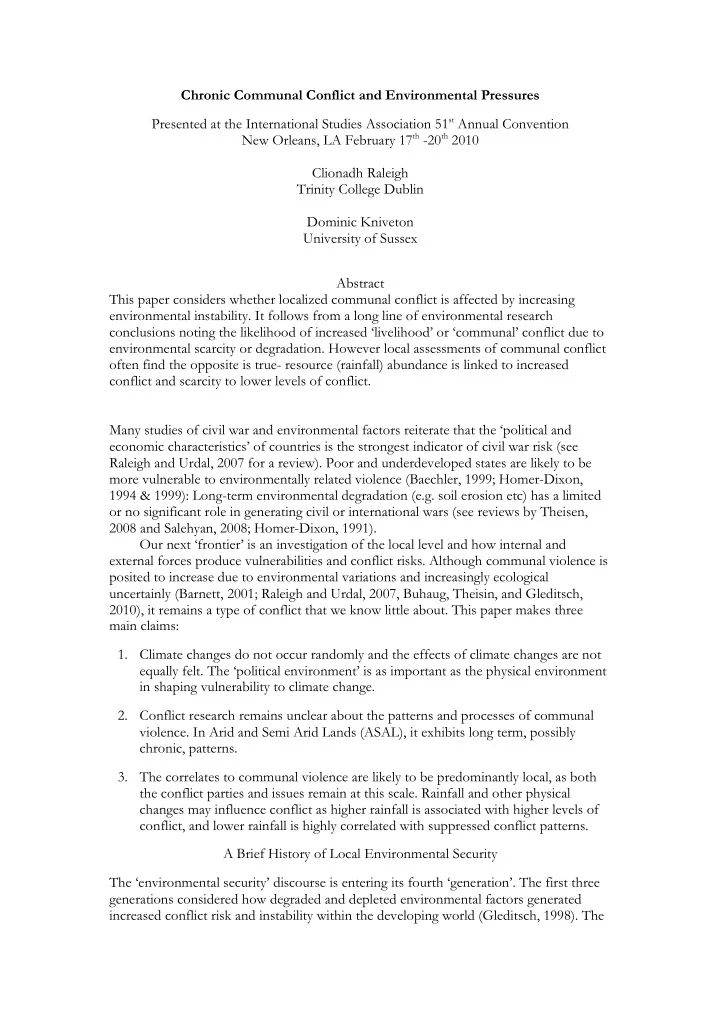

Chronic Communal Conflict and Environmental Pressures Presented at the International Studies Association 51 st Annual Convention New Orleans, LA February 17 th -20 th 2010 Clionadh Raleigh Trinity College Dublin Dominic Kniveton University of Sussex Abstract This paper considers whether localized communal conflict is affected by increasing environmental instability. It follows from a long line of environmental research conclusions noting the likelihood of increased ‘livelihood’ or ‘communal’ conflict due to environmental scarcity or degradation. However local assessments of communal conflict often find the opposite is true- resource (rainfall) abundance is linked to increased conflict and scarcity to lower levels of conflict. Many studies of civil war and environmental factors reiterate that the ‘political and economic characteristics’ of countries is the strongest indicator of civil war risk (see Raleigh and Urdal, 2007 for a review). Poor and underdeveloped states are likely to be more vulnerable to environmentally related violence (Baechler, 1999; Homer-Dixon, 1994 & 1999): Long-term environmental degradation (e.g. soil erosion etc) has a limited or no significant role in generating civil or international wars (see reviews by Theisen, 2008 and Salehyan, 2008; Homer-Dixon, 1991). Our next ‘frontier’ is an investigation of the local level and how internal and external forces produce vulnerabilities and conflict risks. Although communal violence is posited to increase due to environmental variations and increasingly ecological uncertainly (Barnett, 2001; Raleigh and Urdal, 2007, Buhaug, Theisin, and Gleditsch, 2010), it remains a type of conflict that we know little about. This paper makes three main claims: 1. Climate changes do not occur randomly and the effects of climate changes are not equally felt. The ‘political environment’ is as important as the physical environment in shaping vulnerability to climate change. 2. Conflict research remains unclear about the patterns and processes of communal violence. In Arid and Semi Arid Lands (ASAL), it exhibits long term, possibly chronic, patterns. 3. The correlates to communal violence are likely to be predominantly local, as both the conflict parties and issues remain at this scale. Rainfall and other physical changes may influence conflict as higher rainfall is associated with higher levels of conflict, and lower rainfall is highly correlated with suppressed conflict patterns. A Brief History of Local Environmental Security The ‘environmental security’ discourse is entering its fourth ‘generation’. The first three generations considered how degraded and depleted environmental factors generated increased conflict risk and instability within the developing world (Gleditsch, 1998). The
first generation contended that increasing population growth rates were going to exhaust natural resources. The second generation is characterized by Homer Dixon’s interrogation of how resource scarcity, abundance and differential access within the developing world would result in large-scale violence and political instability. Homer Dixon and others present complex interactive flowcharts detailing the relationships between the physical environment and political change. However, these complex relationships defied quantification and ignored other conflict generating factors. The third generation largely focused on empirical models of conflict. Once quantified and considered in tandem with other conflict generating factors, it became evident that the previously promoted relationships assigning a position of primacy to environmental factors was largely incorrect. Several studies found a weak, if not insignificant, correlation between land degradation, water scarcity, and civil wars (Nordas and Gleditsch, 2007; Raleigh and Urdal; Buhaug et al, 2010). The conclusions of the third generation found that scarcity of either precious or renewable resources did not increase civil war risk. Current State of Research Only in the last few years have researchers debated how climate changes would affect political stability and conflict rates across the developing world. Climate change is expected to bring about significant changes in rainfall and temperature patterns in the long term, and increased frequency and intensity of disasters in the short term (30-50 years). Therefore, although physical changes are imminent, climate science remains unclear about the localized effects, the time scale, and what will occur within sub Saharan Africa (Williams, Kniveton, Layberry, 2008). This has reignited the discussion regarding the potential links between physical and political changes. Cross-national and sub national quantitative studies have again dismissed the connection between present physical changes and civil war and small scale qualitative and empirical studies have emphasized that a sub national political, economic and social vulnerabilities shape the risk and type of conflict risk well above the physical risks. Nonetheless, studies linking climate changes to conflict via rainfall or temperature variations continue, as evidenced by Miguel, Satyanath and Sergenti (2004) or Burke et al (2009). Many of these new ‘security’ studies rely on rainfall and temperature vacillations as their proxy for scarcity and ecological instability. Rainfall shocks are a reliable indicator of climate change as precipitation changes are a direct form of short and long-term instability. Empirical studies linked precipitation and temperature to conflict tend to: 1) be cross national, although they address sub- national variations in both ecological and conflict conditions 2) rely on the assumed primary of ecological risk; 3) use simple temporal correlations to base their results and 4) mis-specify conflict types and overall correlates in high risk states 1 . !!!!!!!!!!!!!!!!!!!!!!!!!!!!!!!!!!!!!!!!!!!!!!!!!!!!!!!! # ! Burke et al’s method is to examine the countries of sub-Saharan Africa over a relatively short period (1981-2002) and ask what was the average temperature during the calendar year, and were there 1,000 battle-related deaths in that year or not? By including major controls of a fixed country effect assuming that due to physical, social and colonial characteristics or other ‘unchanging’ factors, some countries have a uniformly higher or lower risk of conflict than others. They also include a linear-time effect, under the assumption that in each country some steady improvement or deterioration (due to increasing wealth or increasingly poor government) may be causing a steady, uniform rise or decline in their risk of violent conflict during this period (Goldstone, 2010). As Goldstone notes, to use such singular controls in a regression is incorrect as it implies any short term changes are not applicable to a study of quickly changing entities. ! ! "
Recommend
More recommend